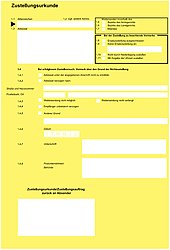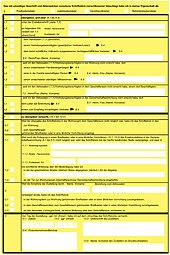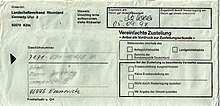Delivery document
In Germany, the document of delivery (ZU), also called the postal delivery document (PZU), is a public document that provides full evidence that a certain, mostly official document has been formally served on a recipient . It is part of a formal delivery that is based on a postal delivery order (PZA).
Official deliveries are not only possible through postal delivery orders. Delivery by handover by an official of the authority is possible (so-called delivery by handing over to the official office , Section 173 ZPO). It is also possible by the bailiff himself, who does not have the document to be served delivered by way of a postal delivery order ( § 194 ZPO) but hands it over personally to the addressee (procedure according to §§ 191 ff. ZPO , in particular § 193 ZPO). These two forms of service are notarized on documents other than the yellow service document dealt with in this article. The yellow delivery forms are also not used for public delivery .
Legal bases
The mail delivery order is regulated in Section 33 of the Postal Act. Accordingly, every licensee of letter services is obliged to carry out mail delivery orders ( Section 33 (1) PostG). If a licensee is not dominant in the market, the Federal Network Agency can exempt the licensee from this obligation ( Section 33 (2) PostG). According to § 34 PostG, the service provider is entitled to a fee for the execution of the order, which is subject to regulation by the Federal Network Agency. Liability when carrying out a mail delivery order is based on the rules of official liability in accordance with Section 35 PostG and is unlimited.
Placing a mail delivery order is reserved for certain user groups. Only official documents are suitable for delivery.
Client can only be:
- Courts that commission deliveries in accordance with the procedural rules ( Section 176 ZPO, Section 37 StPO, Section 15 FamFG, Section 56 VwGO, Section 63 SGG, Section 53 FGO),
- Authorities that commission deliveries in accordance with the laws on administrative delivery ( Section 3 VwZG and corresponding laws of the federal states),
- Bailiff ( § 192 , § 194 ZPO).
The subject of formal notifications is not only official documents. A bailiff can also be served by a natural or legal person under private law with the service of a private document, e.g. B. a residential rental space termination, be commissioned. The bailiff takes note of the content of the document. This form of service proves that the recipient has received the personal document (and not just any document from the sender).
Private individuals cannot carry out postal delivery orders in their own name. Anyone who tries as a private person to submit a mail delivery order to a post office - he would have to have obtained the non-publicly accessible ZU form and the non-publicly accessible yellow envelopes - is usually rejected. Nonetheless, successful mail delivery orders from private individuals do not have the same effects as those of an officially ordered mail delivery order, even if a delivery document has been completed and returned to the client.
Mail delivery orders are limited to domestic destinations as they are sovereign measures. German postal delivery orders that nonetheless end up abroad are often returned by the foreign postal administration as not executable. Nonetheless, successful deliveries abroad due to the return of a delivery certificate completed by the foreign postal administration are fundamentally ineffective under German law; however, the ineffective service can be regarded as cured by the proven actual receipt of the document - as otherwise. The document is then deemed to have been received on the date specified on the postal service certificate.
Mail delivery order
The mail delivery order consists of an outer and an inner envelope as well as the mail delivery certificate prepared by the sender. The postal delivery certificate is usually in a flap of the inner envelope, which are stuck together in the outer envelope. In the outer envelope there is either a small window or an additional label so that only the postcode and the place of the recipient can be seen. The outer envelope also contains the franking and is handed over to the postal company for formal delivery, which opens the outer envelope at the destination and removes the inner envelope together with the prepared postal delivery certificate and delivers it to the recipient.
The delivery is an act of sovereignty. It can be carried out without the participation of the recipient and also against his will. First, an attempt must be made to hand over the document personally to the recipient. If this does not succeed, it can be sent to an adult family member, an adult roommate or an authorized postal recipient (substitute delivery to substitute recipient). However, this can be excluded by the sender in individual cases. If this substitute delivery is also not possible, the item can also be placed in a mailbox or another secure receiving facility if it is not used jointly by more than three people (substitute delivery via mailbox). Otherwise, the document must be filed and a notification about this must be left. The document is deemed to have been served upon service, even if it has actually been deposited. Filing means keeping the document at a collection point for three months. The resignation can be excluded by the sender's advance directive.
The sender can order that the exact time of delivery is to be documented. In addition, the sender can issue instructions as to whether the consignment is to be forwarded in the district of the local court, the regional court or the federal territory if the recipient is at another location or has moved.
Upon delivery, the delivery date and, if applicable, the time of delivery are noted on the document. The postal delivery certificate is filled out and returned to the sender. If the document is deposited, it will be deposited at the place of deposit and returned to the sender after three months. If the delivery cannot be carried out because the recipient cannot be located or a further delivery has not been commissioned, the delivery document is filled out on the front and returned to the sender together with the undeliverable document.
Postal delivery certificate
The sender attaches the post delivery certificate to the document to be served. However, it can also be produced by the postal company as an alternative. The information on the sealed envelope of the document is decisive. Every service must contain a file number so that the document can be identified. The file number consists not only of the reference number of the underlying process of the authority, court or bailiff, but also a further specification. This can also be a literal description such as “notification from (date)” or “summons to the appointment on (date)”. A delivery without specifying the file number is ineffective.
The appearance of the postal delivery document as well as the outer and inner envelope is regulated by the Ordinance on the Introduction of Forms for Service in Legal Proceedings (Delivery Ordinance).
The document of service is a document of public faith ( § 418 ZPO). This means that its content is assumed to be correct, unless it is possible to prove forgery. The deliberately false issuing of a postal delivery certificate is a criminal offense of false certification in the office according to § 348. Public officials within the meaning of this provision are also employees of private delivery services, since they are entrusted with sovereign rights for the delivery of postal delivery orders (§ 33 Paragraph 1 Sentence 2 PostG ).
There are also delivery documents in other countries. In Italy they are called Notifica (giudiziaria) (dt. [Judicial] service).
history
The general court order for the Prussian states of 1793 already provided for letters with a certificate of service. The court received, as identification for the files, a "consignment certificate", later called "file certificate". The postman had to " attest the correct insinuation (delivery) of his duty". In 1838 this agreement was made more precise. The fee for the judicial authorities was 4 silver groschen (Sgr.) In addition to the postage fee for the return of the certificate of insinuation, in 1842 to 3 Sgr. plus postage reduced.
In 1869 the North German Postal District demanded 1 Sgr. For letters with a handling certificate , as they were now called. and the postage.
The German imperial post was 1871 the task for private. The fee was in this case, the usual postage for the round trip and 2 Sgr. / 7 Kreuzer (Kr.) Delivery fee. Registered mail was permitted; in these cases, delivery was made exclusively to the recipient or his authorized representative.
In the postal regulations of 1872 it says: "If the sender of an ordinary or recommended letter wishes to receive a post office certificate about the order that has been placed, a properly completed handling certificate (insinuation document) must be attached to the letter and noted on the address:" With handling certificate '. The address required for the return must be put by the sender of the letter on the outside of the folded handling slip. ”Postage was charged: 1) the tariff postage for the outward journey, 2) an insinuation fee, from a court or notary of 1 Sgr . / 4 Kr, from private persons 2 Sgr. / 7 Kr. And 3) the postage according to the tariff for the return of the handling slip. For addressees in the local or rural ordering district there was an insinuation fee, the tariff-based order fee for letters in the local ordering district or a regional letter order fee of ½ Sgr. / 2 kr.
After the introduction of the mark in 1874, the fee amounted to 10 pfennigs if the sender was an authority or a notary, otherwise 20 pfennigs. In addition, there was the usual postage for the outward journey and 10 pfennigs for the return of the treatment certificate.
On October 1, 1879, the "letters with handling certificate" were renamed "letters with delivery certificate" and the regulations were changed. "If the sender of an ordinary or registered letter wishes to receive a post office certificate for the order that has been placed, a properly completed delivery document and a copy must be attached to the letter; At the same time, the inscription must include the following: 'Here a form for the certificate of delivery including a copy'. The address required for the return must be placed by the sender of the letter on the outside of the folded delivery certificate. "" The provisions in §§ can be found on the order of letters with delivery certificate. 165 to 174 and 178 of the Civil Procedure Code for the German Reich of January 30, 1877, with the proviso that the bailiff is replaced by the messenger of the postal service. A distinction was no longer made between public and private senders, the delivery fee was 20 pfennigs. Either the sender or the recipient had to pay the total fee. There were forms for delivery to lawyers, traders and soldiers, and there was also a “simplified delivery” with a blue form. With normal delivery, the recipient was given a certified copy of the delivery document, with simplified delivery only the date of delivery was noted.
The form of delivery has changed several times. Since 1900, the sender has been able to use simplified delivery for private matters again. Enrollment, indication of value, cash on delivery, the request for an express order and the note "Poste restante" were not permitted for letters with a delivery certificate.
On April 1, 1921, the fee for a franked ordinary letter was set for the return of the delivery document. Formal notification can be ordinary or simplified. With normal delivery, the recipient receives a certified copy of the document; with simplified delivery, only the date of delivery is noted on the letter. The service fee was known as the "formal service fee" from January 15, 1932.
For the Deutsche Bundespost (DBP), the postal delivery order was the formal delivery of primarily judicial documents, which the DBP through the ZPO (Code of Civil Procedure) in §§ 193 ff. A. F. had been transferred. The document to be formally served was treated like a normal mail until the postal regulations of May 16, 1963 came into effect (letter with a certificate of service). Due to a ruling by the Federal Court of Justice, according to which the DBP is liable for errors made by its employees in formal delivery, this procedure was changed. Now a formal request had to be sent to the delivery post office. This application was handed over to the Deutsche Bundespost as a normal letter until the beginning of 2004 in a gray-blue envelope according to the official model. The address of the delivery post office was to be given on the envelope. This envelope had to contain the sealed document with the address of the recipient and another form for the postal delivery certificate. The Deutsche Bundespost regularly only carried out a simplified delivery in accordance with Section 195 (2) sentence 2 ZPO a. F. through. The official gray-blue envelopes could still be used until the end of 2004 thanks to a transfer provision in the delivery form regulation. From May 2004, new envelopes following the official model in yellow were introduced.
Postal delivery orders must be cleared by the sender in advance. The order fee is to be paid in postage stamps or by indicia on the envelope. The fee covers the postal handling (transportation to the destination, delivery and return of the delivery document).
Since November 17, 1964, the following applies to mail delivery orders to the Soviet Zone and East Berlin: The order is not to be handed over to the post office in the official envelope with the address of the delivery post office. The name of the person to be served was to be stated on the sealed envelope with the document.
From October 3, 1990, mail delivery orders and postal protest orders to recipients in the area of the DP (traffic area East) were permitted. The provisions of §§ 39 and 40 PO as well as the fees of the postage fee regulations applied.
Before the liberalization of the postal monopoly in 1997, formal deliveries were only offered by Deutsche Post AG (or before that, Deutsche Bundespost ). Since the amendment to the Postal Act with effect from December 22, 1997, other postal companies have also been obliged to carry out postal delivery orders.
Document of delivery in the GDR
In the GDR, the service document was a document for the delivery of a letter in accordance with the provisions of the Code of Civil Procedure.
Letters with the additional service “certificate of delivery” were handed out under authentication. The place and time as well as the type of delivery - in the case of letters with the additional service "personal delivery", the place and the date of notification - were recorded on the delivery document with the signature of the Deutsche Post employee.
The day of delivery was noted on the letter. The certificate of service was sent to the sender of the letter immediately after it was handed over (status: spring 1979).
See also
- Return receipt letter (delivery certificate in Austria)
- Announcement of administrative acts
literature
-
Handheld dictionary of postal services
- 2nd Edition; P. 596–598 (Article: Postal delivery system)
- 1st supplement to the 2nd edition; Pp. 98–99 (article: postal delivery system)
- Statistics of the Reichs-Post and Telegraphenverwaltung 1893. S. 87 ff.
- Archives for mail and telegraphy . Published on behalf of the Reich Postal Ministry; Postzeitungsamt Berlin W, 1895, p. 110 ff.
- Scholz: The post, telegraph and telephone law systematically presented . Special print off; Viktor Ehrenberg (Hrsg.): Handbook of the entire commercial law . Volume 5, Division II. OR Reisland, Leipzig 1915, p. 95 ff.
Web links
- Mail delivery order. Deutsche Post AG, accessed on April 30, 2019 .
Individual evidence
- ↑ Termination of a lease: registered mail, normal letter or bailiff? , Information on mietrecht.org, accessed on May 31, 2020.
- ↑ BVerwG, judgment of February 20, 1981 - 7 C 29.78 - ; Higher Administrative Court Berlin, judgment of December 2nd, 1977 - II B 98.76 -, juris.
- ↑ BFH, decision of November 25, 1986 - IV S 9/86 - .
- ↑ Federal Law Gazette ; BefriendsVV with pre-printed images (front and back) ( BGBl. I p. 619 )







